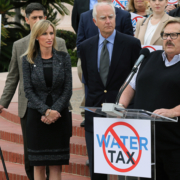A historic achievement for the San Diego region passed almost unnoticed when the San Diego County Water Authority’s Board of Directors adopted new wholesale water rates in late June.
The rate-setting process highlighted how the Water Authority’s independent water supplies from the Colorado River are now both less expensive and more reliable than supplies from the Metropolitan Water District of Southern California. It’s an accomplishment that the region’s water officials started working toward two decades ago, and one that will bear fruit for decades to come.
The value of our independent water supplies will grow in coming years given the rapid increases in MWD’s rates, which have risen far faster than the cost of the Water Authority’s Colorado River supplies secured in 2003 through a complex, multi-state pact known as the Quantification Settlement Agreement.
Historic agreeement secures San Diego economy and quality of life
From the start, that landmark deal helped secure our economy and quality of life by giving us a major new source of water with a higher priority – or legal right – to Colorado River water than MWD. The agreement allowed the Water Authority to transfer increasingly large amounts of conserved water from the Imperial Valley to San Diego, so that by 2020 it will meet about half of our region’s projected water demand.
That visionary agreement also minimized the impact of MWD’s water delivery cutbacks during the past two droughts. In 2015, for example, MWD reduced water deliveries by 15 percent, but the Water Authority’s independent supplies meant we had enough water to meet 99 percent of normal demand.
While the supply benefits of the conservation-and-transfer agreement have long been clear, the region is just now starting to feel the cost benefits as well.
Here’s why: At the start, our independent Colorado River supplies were more expensive than MWD water. However, the cost of the Water Authority’s independent Colorado River supplies is controlled by a contract linked to the rate of inflation, which means those costs are rising far more slowly than MWD’s rates and charges.
Millions in savings achieved
In addition, the Water Authority has benefited from lawsuits that forced MWD to drop illegal charges for delivering our independent Colorado River supplies. A 2017 appellate court ruling netted the Water Authority about $15 million in savings in 2019, with tens of millions of additional savings in years to come.
The combined effect is that the Water Authority’s independent Colorado River supplies are less expensive than MWD supplies by $44 per acre-foot this year. In 2019, the difference will grow to $68 per acre-foot, and in 2020 our independent supplies are projected to be less expensive by $121 per acre-foot.
That’s worth celebrating because it means regional wholesale water rate increases in 2019 are among the lowest in 15 years – a testament to the all those who have worked for decades to secure a safe, reliable and cost-effective water supply for everyone who calls this place home.




